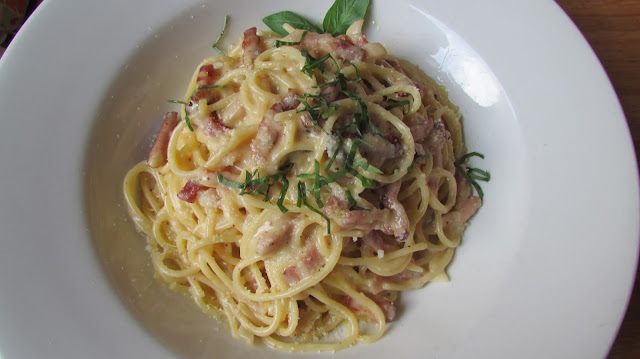Only a week and a half left of our fabulous pasta offer – where you can get 5 of our most classic pasta dishes for just £5 each! These 5 represent some of the best-known pasta dishes Italy has produced, but this week we thought we would share a couple which are a little less famous.
We’ve chosen a creamy-but-hot,
endlessly comforting Roman dish – Cacio e Pepe – and a dinner party showstopper
for the keen chefs among you with spicy Squid-Ink Pasta with Prawns.
Let us start off easy…
Cacio e Pepe
Ingredients
400g Spaghetti
160g Pecorino Romano cheese
Loads and loads of freshly-ground
black pepper
Pinch of salt
Cooking time: 15mins
Method
- Boil water and add a pinch of salt before popping in your spaghetti.
- You'll want your pasta to be al dente so check the packet for cooking time. It's usually about 6-10 mins.
- 1-2 minutes before the pasta is done, get yourself a deep bowl, that is wider than the pan you are using, and place it on top of the pan to warm it. This is a surprisingly important step, since the temperature of the pasta is what will determine the creaminess of your sauce.
- Grate your cheese.
- When your pasta is done, remove it from the pan and pop it in the bowl. Warning: DO NOT THROW AWAY YOUR PASTA WATER. This step is also key! Firstly, the heat of the pasta water will help to melt the cheese slightly, and secondly the starch, which the pasta has released into the water, will help to bind the cheese and the pepper to the spaghetti.
- Add two ladles worth of the pasta water to the bowl of pasta, then add your cheese.
- Stir together, adding more water if the mix is too dry, and more cheese if it is too watery.
- Add as much pepper as you would like.
- Stir until the cheese and pepper have formed a creamy sauce which clings to the pasta.
And now for something a little
more complex…
Squid Ink Pasta with Prawns, Chilli and Herbs
Ingredients
3 tbsp of flat-leaf parsley
2 thinly-sliced spring onions
1 tbsp of mint leaves
1 tbsp of basil
1 tbsp of rinsed capers
3 rinsed tinned anchovies
2 tbsp of olive oil
250g of squid ink pasta
14 prawns; cooked, peeled and
shells removed.
1 small, deseeded, thinly sliced
fresh chilli
A squeeze of lemon juice
Salt and pepper, to taste
Method
- Bring a large pot of water to the boil.
- Set 1bsp of flat-leafed parsley and 2 tbsp of the sliced green parts of the spring onion to one side for later.
- 2. Place the remaining parsley and spring onion in a food processor. Add the mint, basil, capers and anchovies; blending until the mixture is well combined and finely chopped.
- Slowly add olive oil to give the sauce consistency. Add seasoning if needed.
- 3. Once the water begins to boil, add the pasta and a pinch of salt; cook until the pasta is al dente (see the packet for cooking time).
- Return the pasta to the pan and add the herb sauce, chilli, prawns and lemon juice to taste.
- Toss well and serve.
- Garnish with the parsley and spring onion you set aside, sprinkling generously with salt and pepper.
Pasta perfection - which one will
you choose? Will you stun with Squid ink or chill with Cacio e Pepe? Get in
touch on Facebook or Twitter and let us know!










